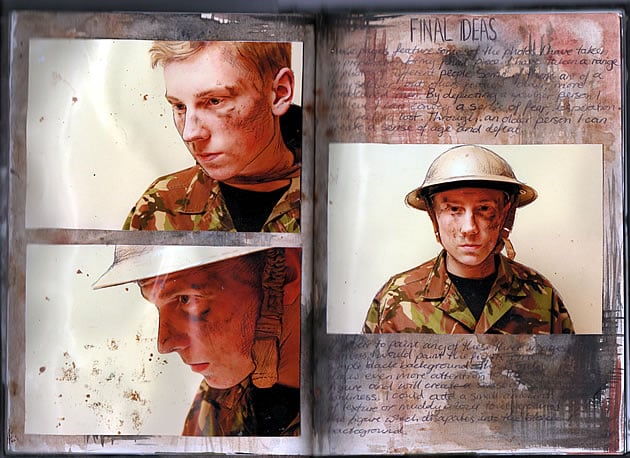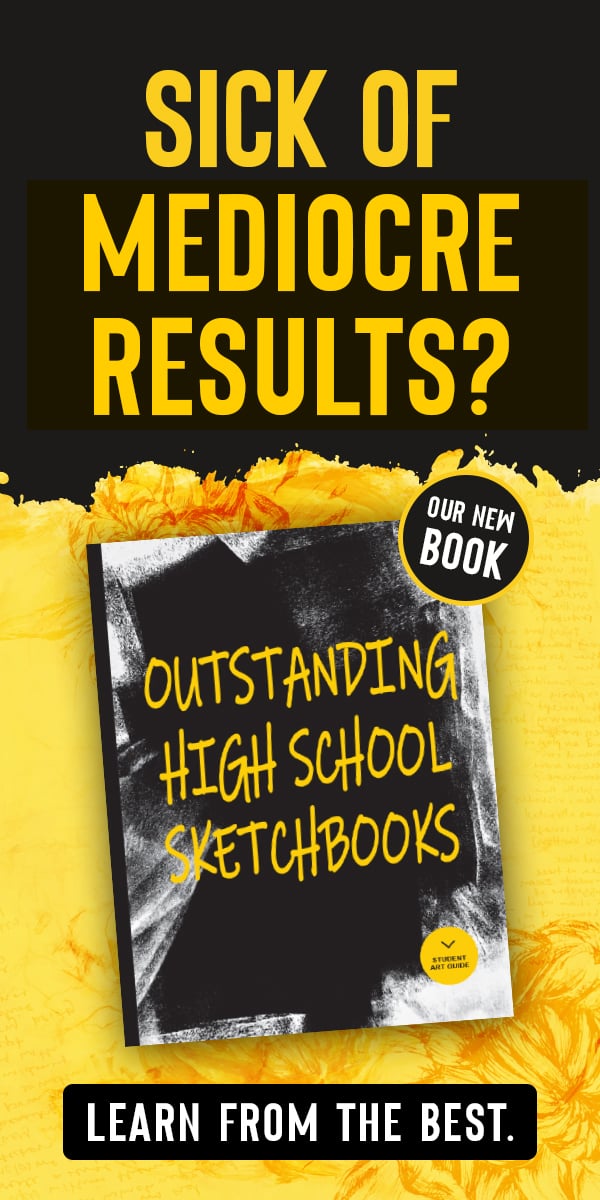Last Updated on April 2, 2023
This A2 Art and Design Coursework project (Unit 3) was completed by Ruth Beeley while studying A Level Art (Edexcel) at St George’s School, Harpenden, Hertfordshire, England in 2011. She was awarded 100% for this component.

Ruth’s work is particularly notable for the way she approaches a challenging topic – one which most high school Art students have little first-hand experience of: War. Her emotion-filled sketchbook pages and skilful final works investigate different aspects of this theme (combat, injury, loss, grievance, war games and media propaganda) finding connections with her own life, such as displaced emotions, ostracised feelings and concepts of ‘the Other’ (as explored while studying Othello in her A Level English class).
We were lucky enough to interview Ruth about her project. Her responses are below:
Students can sometimes be unsure how to work from first-hand sources when a topic doesn’t have an immediately obvious practical connection to their life. Your project is an excellent example of how to approach this. Please describe the first-hand sources you found or created while exploring your War theme. Ruth: It was difficult obtaining first hand resources for this topic, so I partly found and adapted images from war books; for example I colourised the iconic photograph of St Paul’s Cathedral and used a dip pen to replicate an image of a line of soldiers. I referred to the work of James Nachtwey who, unlike myself, has travelled to countries at war in order to document and present to us the realities of it. When it came to creating my own pieces I obtained a WW1 helmet and clothes that looked similar to an army uniform. I took a range of photos of people close to me, and tried to imagine what it would be like if they were at war, provoking emotion in myself and hopefully in my work.






You have used a large range of mediums within your project, resulting in rich, layered, textural sketchbook pages. How did this approach benefit your project? Ruth: Where I used dense, uncoordinated materials, I was trying to replicate the destruction and confusion of war. Whilst the theory of battle is mathematical and planned, the reality is not and is instead clouded with blood, dirt and emotion. For example for the ‘Uncle Sam’ piece, I took the classic Uncle Sam propaganda poster and covered it with acrylic, sand, wire, coffee, lentils, porridge, biro, scrim (strips of loosely woven fabric), Modroc (fabric coated in Plaster of Paris) and created a solution of ink, water and PVA for blood. I intended to highlight the irony of propaganda posters which glorify war without showing the destruction of it.

Which artists did you study as part of your project? How have these influenced and shaped your work? Ruth: When creating my ceramic piece I looked at Penelope Batley’s twisted sculptures and Robert Arneson’s war-related pieces, such as ‘General Nuke‘. I liked the way General Nuke has the ability to make the viewer uncomfortable, and certainly depicts a negative image of war. Similarly I wished to create a sense of unease, however where Arneson did this through sculpting an evil-looking general, I sculpted one of the victims of war. The soldier’s face is a picture of pain and anguish and the back of his head is caving outwards as if shot. As there is no ‘entry wound’, the piece could be a visual representation of the psychological damage that war inflicts, as well as the physical. I looked at war memorials, noting how the lists of killed soldiers induce feelings of loss in those who view them and put the number of killed into perspective. Finally, wanting to create a cinematic, realistic painting, I looked at war photographers, such as James Nachtwey. Whilst Nachtwey captured images that I do not have the opportunity to capture, I also considered his composition and lighting, thinking how I could apply it to my final piece.



What advice do you have for other high school Art students who wish to gain excellent grades? Ruth: I achieved my grade by simply covering all areas of the brief; I included plenty of research, first looking through magazines for inspiration, moving on to artists, photographers and articles. I used a range of media and worked both in sketchbooks and on A2 sheets, producing a large body of work and therefore ensuring that all areas were covered. The ceramic sculpture was a side project that again ensured a range of materials were used and brought me into the third dimension. The concertina sketchbook was good in presenting a thought process and a constant stream of work.





If you enjoyed this article, you might also like view 20 Creative Sketchbook pages – an article in which Ruth’s work has also been featured!

